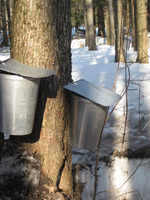Entries in Food writing 2013 (4)
The downside to the foraging trend
La Faune et La Flore
Another hurdle for Les Jardins Sauvages
Good thing we’re made strong and love what we do!
Profile: Les Jardins Sauvages, Pioneer and leader in Quebec Wild Edibles. 28 years in business, constantly evolving.. Now with a permanent stall at Jean Talon Market in Montreal & acclaimed Country Restaurant in St-Roch de l’Achigan; 100+ products fresh, 100+ products preserved; A Forager and Chef team with experience, long committed to quality, local and wild, artisanal and sustainable food..
I'm told I don't toot my own horn enough, see I'm practicing..
In case you don’t know, Jardins Sauvages is the original wild foods business in Quebec. Long before anyone heard of Noma, François was foraging, the first to introduce chefs to wild greens and many local wild mushrooms. He spent years of walking the through the weeds & woods of Quebec to find healthiest spots to harvest each species; he intimately knows nature and how to pick for quality and sustainability – where, when, what time of day, what stage in the cycle. Working with Quebec’s top chefs, he refined his skills, learning what was best picked young, cooked in numerous ways. And now, I’ve been cooking his wild stuff for 13 years since I met him at L’Eau, on a full time basis since 2005. I’ve figured out what’s best how, say raw or cooked or dried, savoury or sweet, what mushrooms benefit from a sauté or a slow braise, how to put them up. We were the first to make mushroom ice cream and chocolate, to smoke mushrooms, to cook with cattail pollen, promote local teas & spices or pick and cook marine greens in so many ways - paving the way, showing people what could be eaten and how. Unlike some of the newcomers jumping on the foraging bandwagon, we know what we’re doing.
Nonetheless.. a few weeks ago, we got a visit from a couple of officials from La Faune et La Flore, a governmental arm that regulates the environment, forests and fishing. We should have nothing to fear, buy nay and yay, another battle is before us. They are banning crinkleroot and wild ginger, among other things, but these two affect us most, a dozen of our products, our menus.
The funny thing is that they were especially eager to pay us a visit because I had put wild garlic (ramps/ail des bois) on my menu this spring. In ten years, I never dared, but then I saw all Montreal chefs with ramps on their menu, and I figured if anyone should have them on the menu it should be us, given that the wild thing is our deal, we have tons on our property, and know how to harvest sustainably and all. Not to mention that it was just a few leaves from our field, ciselé as a garnish for a soup for 10 clients. Meanwhile, restaurants serving 100+ clients a night with anonymously sourced and less sustainable garlic don’t have an inspector in sight. BTW apparently, whether it’s from Ontario or New York, the law stands, not allowed. Anyway, it’s not like I’m tattling on other chefs, I just want to be able to do what we do. I have never even ever heard of a Montreal chef bothered by the F&F. It’s such a joke that they’re at our door.
Like with wild garlic, they have decided that crinkleroot and wild ginger are endangered species and need to be protected. We agree that they need to be protected, in that they need to be harvested with care and knowledge first and foremost, not completely ripping out the plants. Especially that the foraging trend means that there are new players in the game (many uninformed, unconscious or overly ambitious), evidently, some kind of general regulation is in order, maybe permits? In any case, there needs to be an official protocol for wild edibles, all above board, a traceability, an approved list of what can be harvested and how, where, by who, sold how and for what price, all registered. A common code of ethics was enough before, but given the current climate, we are all for this. However, it is complicated to regulate; for the govt, much easier to ban.
In the meantime, it certainly isn’t fair for us, for François who has been doing it properly for 28 years professionally and plus. He was the first to put most wild edibles on Quebec menus - before they were being imported from France (like salicorne, mushrooms) or simply weren’t known to chefs (like wild ginger, orpin, day lily buds, milkweed, arroche de mer, caquiller, the list is long..). He is in the same patches year after year, observing and taking care of nature while he harvests; he gardens the forest. We have more crinkleroot every year, more than enough wild ginger for our needs. He has seen the progress of the crinkleroot for 50 yrs+ because they are family spots. His family has always eaten crinkleroot; we continue the tradition of making his great-great grandfather’s Henri Rochbrune crinkleroot mustard, but 100+ years later, now we’re not allowed.
All to say, these plants obviously aren’t endangered in François’ hands. There is a way to pick that stimulates the plant if it is in a healthy environment; he knows when to leave it alone. He invited the govt officials to visit his terrain, encouraged them to follow him and bring their scientists/advisors to study his reality, to open their minds. He does not understand where they get their data. They’re worrying about fiddleheads and spring beauty? C’mon, just come here and see. How much we harvest from the same land every year. Their sources are from controlled studies, another micro-climate, labs, foreign or outdated books, I don’t know. One thing for sure is that the pencil pushers and botanists aren’t in the Que woods on a daily basis like François.
On top of it, we are a small diversified business, dealing in small volumes according to nature - a little bit of this and that, all sustainable, with our spots on private territory, maintained year after year, no big threat. We led the way, and now because wild foods are becoming popular, we are penalized. Because there are others including some hacks who are just in it short term for a bang or because they think they might like doing this but don’t know squat or care to do things right, or want to exploit a lot of one thing.
Not all foraged food is equal! There is properly sourced, properly harvested and there is ravaged. There is sweet, and threre is bitter. There is tender and tough; delicious and disgusting, nutritious and toxic.. Few in the marketplace seem to know or care about the difference. As long as it’s wild or Nordic, sounds good on a menu. Sadly, marketing seems to count more than quality or integrity. Obviously we have some marketing to do.
We hate to see so many bad foragers around spoiling it for the rest of us, but, it is also important to note that most of the destruction of vulnerable plants and biodiversity is due to development/urbanisation. François has seen so much simply disappear because of autoroutes, Walmarts, condos and parking lots.., way more havoc wrought this way than any bunch of pickers could do. More than once, François had proposed a solution to mayors/municipalities, say when they were bulldozing to make the 50, destroying so much rich land where there was tons of wild garlic, ginger, crinkleroot and much more; he wanted permission to go and save some of the plants. His project got bogged down in beurocracy and never worked out, but he said that in a day, he could have saved enough wild ginger to supply us and every chef for a lifetime. You’re not allowed to pick the wild garlic or ginger, but they’re allowed to bulldoze it. Doesn’t make sense.
It’s not just chefs and back-to-earth types getting into foraging. As the far away regions try to develop their resources and put people to work, the exploitation of the forest and land has become key. Backed by Govt money, they have been training unemployed volunteers to forage, small businesses opening and they’re all trying to find markets. All dandy in theory, but it’s a mess. Too many students expecting to make $$ picking mushrooms they can barely identify. Detached investors wanting to harvest too much. We have no choice but be implicated. François is working in Lanaudière and also with other regions as various agencies and business groups try to sort it out. They need his expertise, and he wants to make sure they aren’t making decisions that don’t stand up. For instance, the tentative list of mushrooms allowed for sale excluded 30 varieties that we use (because the powers that be don’t know them well enough). Like when François started selling wild mushrooms 20 years ago, many didn’t believe him that there were wild mushrooms in Quebec. He’s come along way, but now everyone is catching up to him. All this is so much time and energy in meetings and paperwork, just to be able to continue doing what we’ve been doing forever - now that the govt., big business, foodies, tree huggers and everyone else is waking up. It’s crazy and no one knows what’s going on behind the scenes.
I thought it would be smooth sailing for a while when we were finally fine with the MAPAQ (the food inspection part), but no now, it’s something else; I swear we have the most complicated business in the world! You see, they just don’t know what to do with us because we do something so different they don’t understand and it worries them. Whether it’s about picking nettle, cooking fiddleheads or milkweed, marinating mushrooms or smoking duck, they’re on our ass. All our products have passed all tests, but it was still a fight to prove that our mushrooms were properly dried, that our pickles and oils and etc are properly made, etc. Meanwhile, cheap imports don’t get any scrutiny, Montreal chefs have toxic plants garnishing their menus. I understand that there have to be rules and inspectors, but why just us? I know what I’m doing and it kills me to talk circles around the inspectors who don’t have a clue about what they’re inspecting. We’ve seen it in the field, the guys thinking we’re picking garlic and its trout lily, they don’t know the difference. In the kitchen, it’s the same. They just want to check off lists: They check your fridge/freezer temperatures, soap and towels next to the sink, all the norms etc; do you have a ph-meter, a register for your products, sanitizer.. Yes, yes, yes. Do you douse everything in Javel regularly and boil everything for 20min. They want you to be a stainless steel aseptic factory that makes one sterile product en masse, easy to verify. We do everything right but we’re not that. You need to be a fighter to be an artisan in Quebec.
It seems to me that we’re the kind of Quebec terroir business that they should be favouring, but no it’s too complicated. They really don’t make anything easy for a small, artisanal business ‘thinking outside the box’ in Quebec. Unless you’re in a far away region where there are subsidies (like most of the newbies). The rules, the taxes, the cost of having employees etc.- its all conducive to big business. We manage to win them over, proving ourselves one person, one product at a time, one costly fight after another. I wish I could just cut out the inspectors who are just doing their job and deal with their bosses, even better, exchange with their scientists.
I figure when I retire, I should get a job as a Govt inspector, I know more than most of them, and I bet the benefits must be nice.. But what a boring job, no thanks. I’ll continue to fight to make a living while focusing on quality, delicious local food; maybe teach them a thing or two along the way. And perhaps things will change one day; Hopefully we will go on to survive and thrive. Others will surely profit down the line. We’re constantly breaking down barriers, teaching, making people taste new things, opening markets, developing.. all while taking the heat and struggling to stay afloat. By nature, it is a difficult business venture; I could do without the extra headaches.
Our passion and vocation has become a cause, a crusade. A fight for anti-industrial small community based business, and for quality, local food and traditions - especially wild things harvested and cooked properly, with a love and respect of nature. That is and will be our legacy if anything, whether recognized or not. If only legacies paid the bills. Seeing L’Eau à la Bouche close after 35 years and a lifetime of Anne Desjardins’ visionary, pioneer work in promoting local artisanal food and top-notch authentic cooking, I know very well that life is not fair.. Oh well. I’m still not willing to trade my quality of life for another. Rant over.
June 2013, the month of plenty
What’s in season? So much! Our menu says it all.. Jardins Sauvages summer menu July
No actually, not even quite – there is only so much you can jam into one five course meal..
Photos: Until I can find the time to fight with my blog, this will have to do:
https://www.facebook.com/media/set/?set=a.403586316349603.80613.248095141898722&type=3
C’est l’abondance! In St-Roch, this is the best time of year for variety of wild edibles – shoots, greens, roots, flowers, vegetables.. And with all the rain we’ve had, everything is green, the wild plants better than ever, gorged with water hence less bitter; things are going fast. As long as there is the occasional sunny, dry spell, this is all good for us. Except that we have to be on our toes; if mother nature is on speed, we have to follow or miss out for the season, not to mention our mission of putting up for the year.
Our mesclun has morphed, officially more summer than spring now with lambs’ quarters, live forever, daisy, lady sorrel, garlic mustard leaf, some crinkleroot leaf still, a variety of petals for colour and zip.. The last of the spring beauty, violets and acacia, rose petals and day lily moving in..
The marine greens are starting to come in from Kamouraska: beach peas, goat’s beard, sea parsley.. It won’t be long before we happily add sea spinach and sea asparagus to the basket.
Thanks to a wet month of June, local mushrooms are showing up early – its still morel season in some parts of Quebec, but here already some choice boletes like the yellow (bolet granule) and orange cap, as well as wine caps.
Milkweed broccoli is out, daisy buds too. We have a few weeks ahead focused on the oh-so-popular (but labour intensive daisy buds). The cattails aren’t far off, another big job with a short window. We peel the young cattails and then harvest the next stage – the pollen, drying and pulverizing it to make a flour/seasoning. For a week, my kitchen is covered in yellow dust and I blow my nose yellow at night. Goes with the territory, like black fingernails in mushroom season.
Let’s just say that cattail season (also elderflower, sweet clover, wild strawberries, the first mushrooms..) is not good timing to take off.. But as it happens early, François will be in ‘le grand nord’ for a week of fishing and prospecting, and I will be in Toronto representing Jardins Sauvages for the Ace Bakery Incubator Awards; hopefully we won’t miss out on too much with everything sprouting so fast..
Amidst it all, I try to occasionally get my coureur des bois and forager for the stars (or as he prefers to be called, Jardinier de foret) on tape. It’s all very on the spot and amateurish, but a fun start.. I promise we will make a point of capturing the moment more often and hopefully get better at it in time, with more English too once I get used to my phone/camera, keeping in mind that following François is never easy. So, anyway, here are the little videos on foraged wild plants we have so far.. (In French, although I usually throw in a word or two of English if I remember to): http://www.youtube.com/my_videos?o=U
'Live in each season as it passes..'
“Live in each season as it passes, breathe the air, drink the drink, taste the fruit, and resign yourself to the influences of each.” Henry David Thoreau
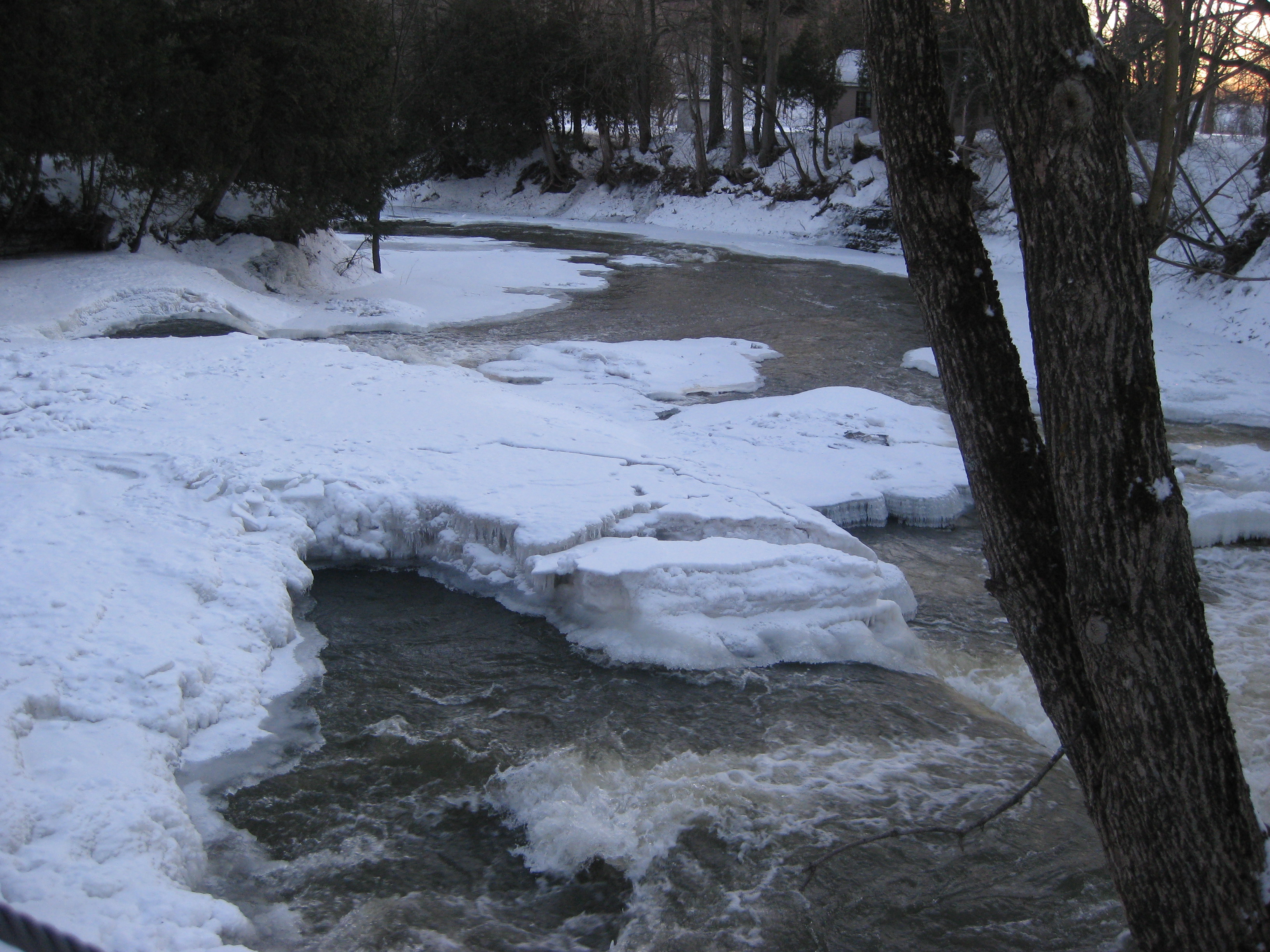 The view from my smoker (smoking my duck)I’m doubly inspired to share one of my favourite quotes with you..
The view from my smoker (smoking my duck)I’m doubly inspired to share one of my favourite quotes with you..
For all the winter haters out there, I’m tired of hearing you whine. Get out there and enjoy it! Soak up some of that bright sunshine, put on a pair of snowshoes or skis, play in the snow, and relish how sweet the crisp, fresh air feels.. Spend time in the kitchen cooking comforting dishes; share a hearty wine-soaked meal with friends next to a fireplace. Visit a Nordic spa. Snuggle up on the couch and read a book. Like ‘The Kitchen Daughter’ (a novel I loved). Root through your bookshelf and you're sure to find a long lost treasure such as my latest retrouvaille, ‘The Great Chefs of France’. Pick up a glossy, inspiring cookbook such as Jerusalem, Toque, Joe Beef or anything by Thomas Keller. Maybe some heartwarming foodwriting (Ruth Reichl), stimulating (Taras Grescoe) or laugh out loud (Jeffrey Steingarden). Or how about one of those 'Canada Reads' picks..
I love winter for all those reasons, and also because my cooking takes on a different tone, the kind of food that only feels right at this time of year. Less inspired by all the fresh and local produce, it’s more about going back to the classics and creatively using inventory, making the most of my preserves. There is less green crunch and more duck fat. I dip into my freezers, reorganizing them. I spend time admiring my gardemanger as I pull out a jar of pickled beans, smoked shrooms or crinkleroot canned tomatoes, enjoying all that hard work of putting up in summer. With a lot more time alone in the kitchen too, I have time to take stock, to look back and think ahead, to play catch up – be it with cleaning, operation details or recipes. To work on new and parallel projects – like my blossoming apothecary!
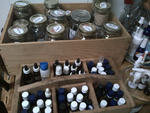 a glimpse of my witchery: medicinal plants, essential oils
a glimpse of my witchery: medicinal plants, essential oils
Back to the second trigger for the Henry David Thoreau quote..
Another annoying thing that has occasionally interfered with my good winter mood is all the premature maple talk, which seems to have started right after Christmas – in the media, themed dinners and events all over. Granted, there is nothing wrong with celebrating one of our national treasures anytime if it makes you happy. Rather, it’s the undercurrent relentless rush to 'the next thing' permeating our culture that bothers me. Perhaps led by journalists and wannabe trendsetters who need to be the first to showcase what is new and hip.. Definitely, there is the commercial machine wanting to cash in on Valentine fervour as soon as the X-mas trees are down and on Easter bunnies as of Feb.14th. Go to a boutique in winter and you only find summer clothes – this has always baffled me. And local ‘market cuisine’ restaurant menus that follow someone else’s seasons?!!
Why can’t we just savour the moment and take things as they come really. Like enjoy winter now and get excited about maple syrup when the sap is running in earnest in a month or so. Next thing it will be morels, peas and asparagus on menus, magazine covers and blogs two months in advance.
Trust me, following our own seasons tastes better. And every season is beautiful if you take it in, pay attention and live it fully. If there’s anything I’ve learnt living and cooking on the wild side in the country, it is this and I’m happy for it.
For myself anyway, I honestly cannot be inspired on an artificial timeline; I don’t ‘feel it’ until it’s in the air. I have a hard time putting out a menu in advance, yet from a business point of view, I have realized I have no choice. I still wait until the last appropriate minute and inevitably make changes when the day arrives so that it absolutely rings true. With a job/vocation fuelled by passion, integrity, and so much blood, sweat & tears, I just couldn’t have it any other way. Besides, I just love the seasons, I don’t want to be thinking about the next one until it’s time, life is too short.. It would feel like a betrayal. Maybe it is my way of staying grounded and paying tribute to nature and ‘God’ and all my blessings..
So, in the dinosaur spirit of hanging on to the moment, I will be cooking my Wild & Aphrodisiac Valentine’s menu until Sat. Feb.23rd, and then we close in March (at La Table, not the market), a break to take advantage of winter’s end and regroup. And when the maple season is actually peaking and we have fresh sap and syrup, we will start again with a wild maple themed menu!
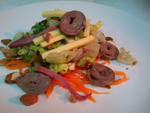 duck heart salad with duck egg, smoked duck, carrot, pickled mushrooms, wild mushroom vinaigrette
duck heart salad with duck egg, smoked duck, carrot, pickled mushrooms, wild mushroom vinaigrette
Duck, duck.. And Recipes
I just love my duck
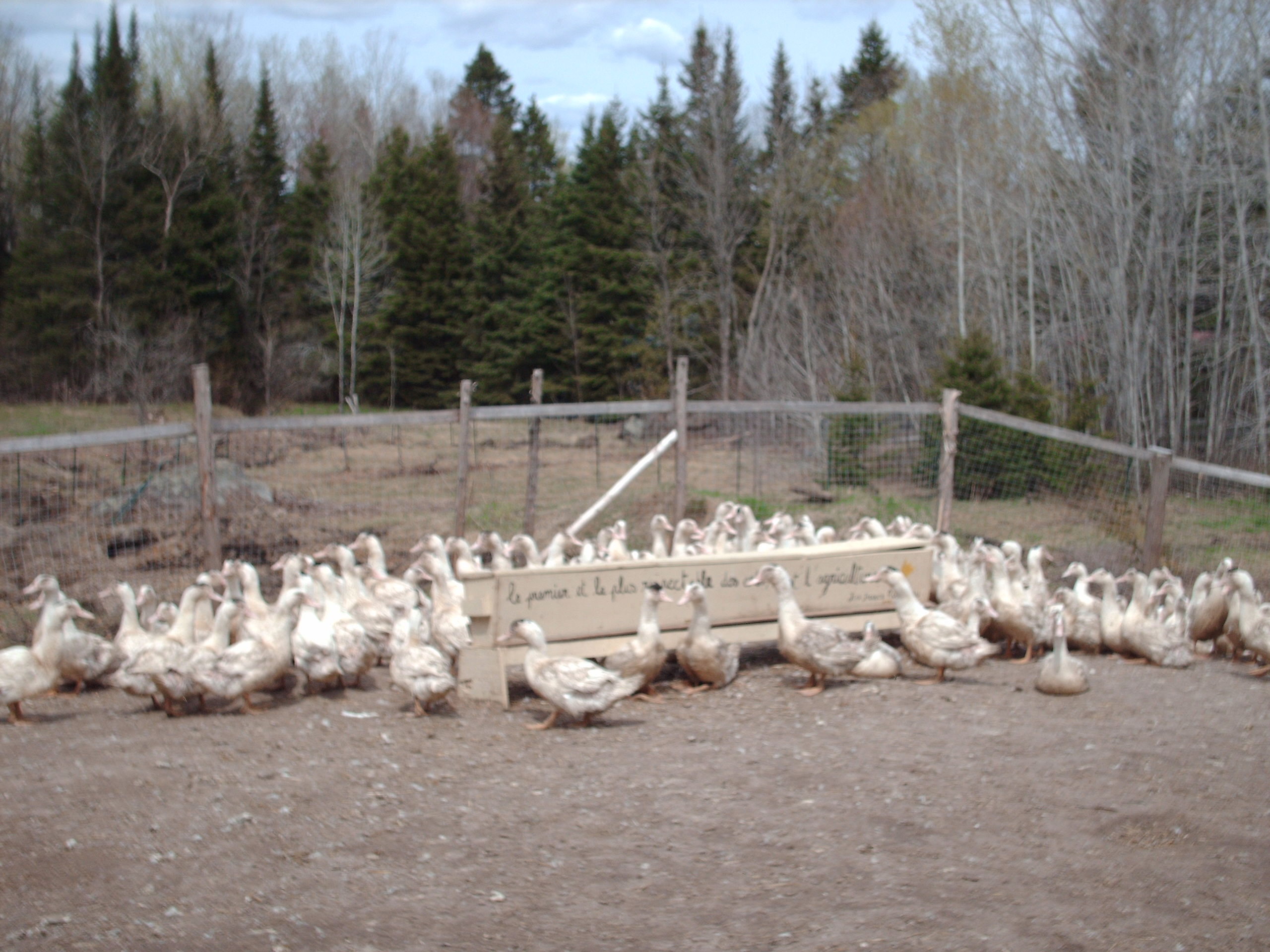 Moulard ducks
Moulard ducks
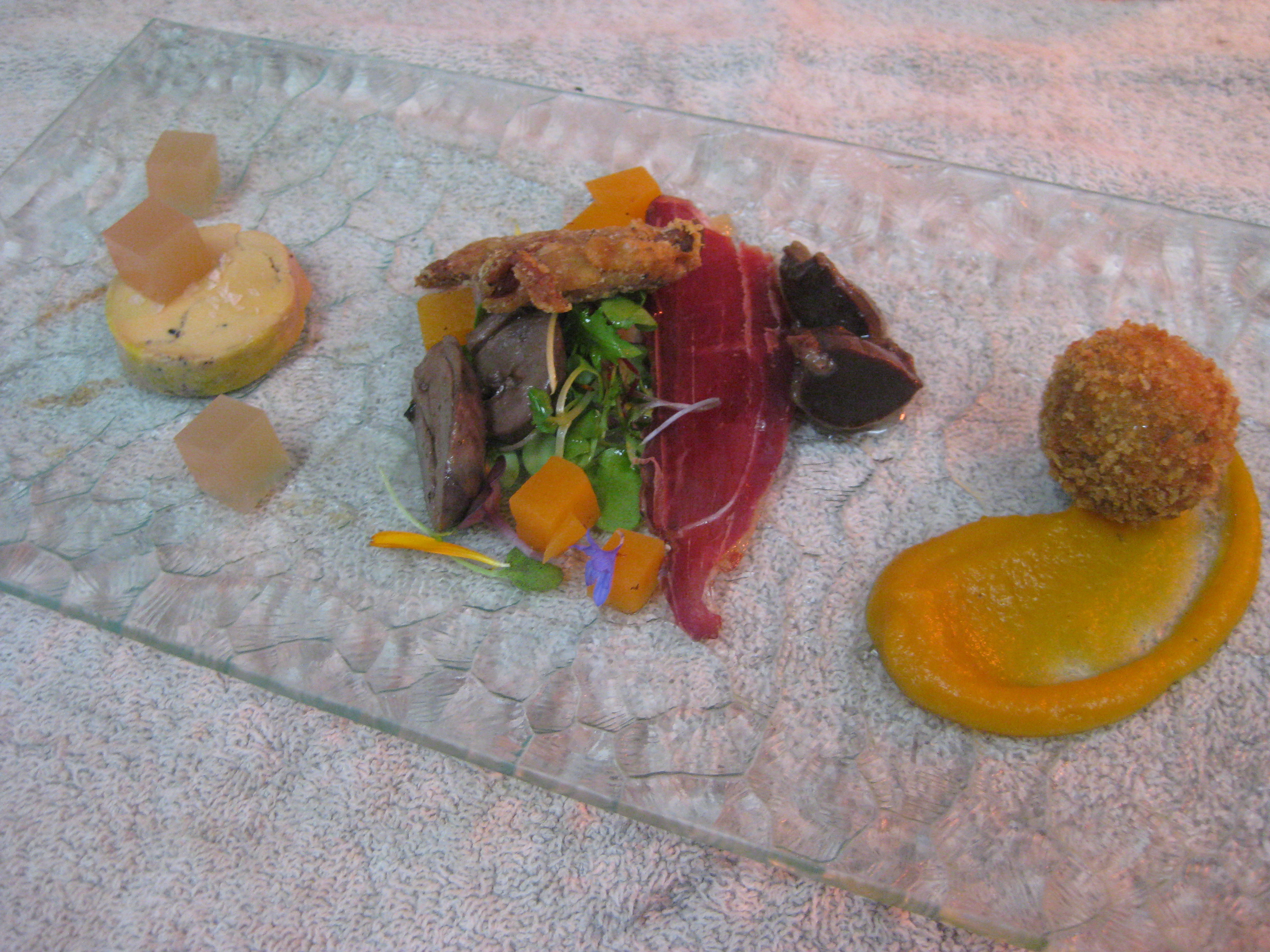
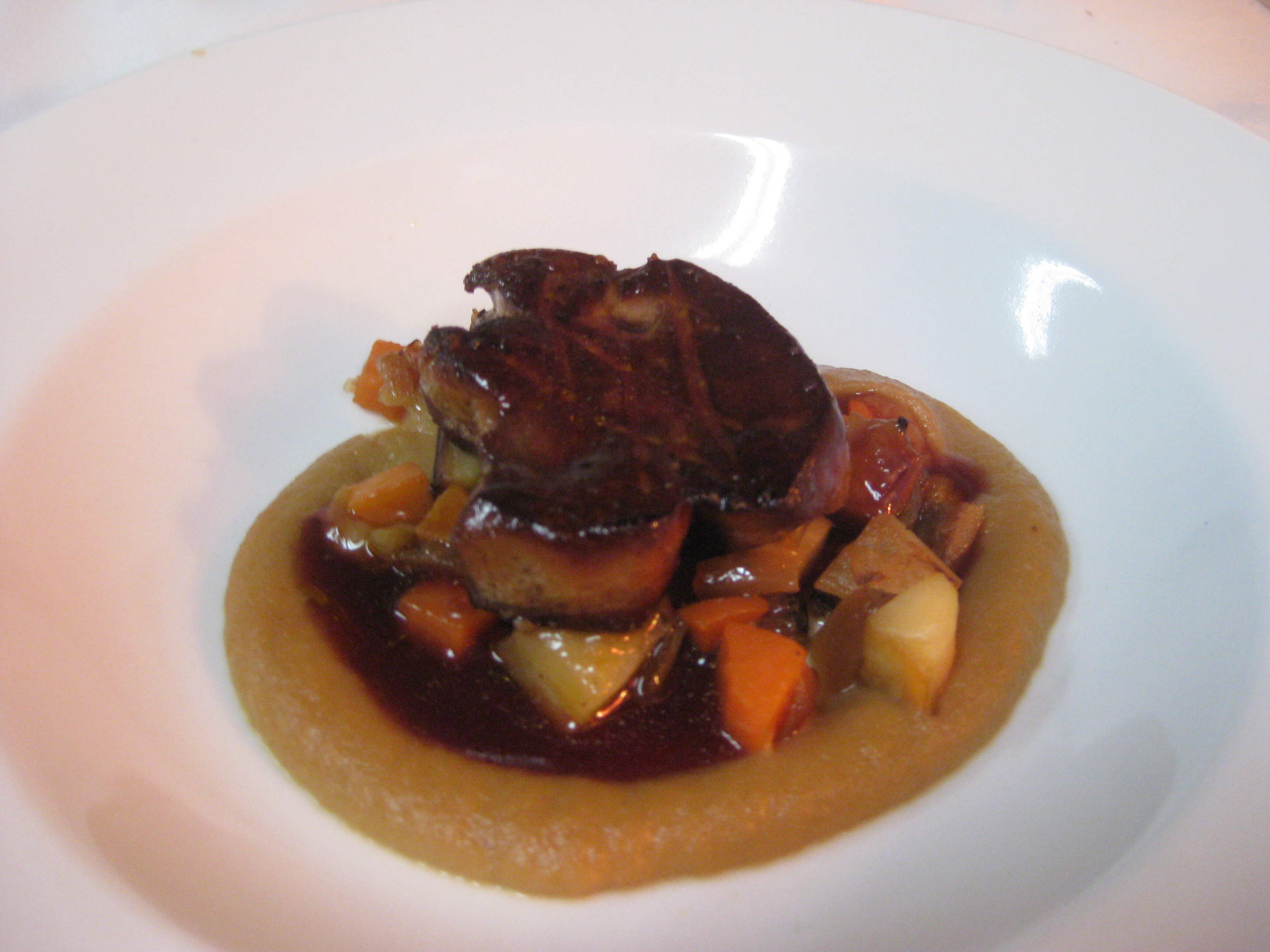 Pan-seared foie gras with elderberry/flower sauce, topinambour soubiseDuck is a winter tradition of ours, and it’s that time again. No matter that I inhaled my share of duck fumes, cooking up an insane amount of duck during the holiday season, I have a few more weeks yet of bathing in duck fat with our duck themed dinners running at the table champêtre.. Duck menu at Les Jardins Sauvages
Pan-seared foie gras with elderberry/flower sauce, topinambour soubiseDuck is a winter tradition of ours, and it’s that time again. No matter that I inhaled my share of duck fumes, cooking up an insane amount of duck during the holiday season, I have a few more weeks yet of bathing in duck fat with our duck themed dinners running at the table champêtre.. Duck menu at Les Jardins Sauvages
But really, I don’t mind; duck is hard to tire of. It is hands down the best meat, so flavourful and versatile in its many forms, not to mention local, healthy and relatively easy to cook. Susan Semenak makes a case for duck (with my help) in this Montreal Gazette article..
Every year, I change up the seven course menu, playing with four breeds and all their parts, the eggs, the skin, broth etc.. And the marvellous fat of course.. Duck fat is my all-purpose cooking fat in winter, rendered from the carcasses and skin. I like to smoke it too, to have a block ready on hand for introducing that ‘bacon’ taste when you don't want the pigginess.
For sure, there are standards that come back every year or two but always treated differently. For instance duck confit has to be present, but it might be as rillettes, in a salad, in cassoulet or choucroute, say.. Charcuterie (duck proscuito, smoked duck, jerky, sausage) as well as Foie gras, hot and cold are always featured, but with various seasonings and accompaniments.
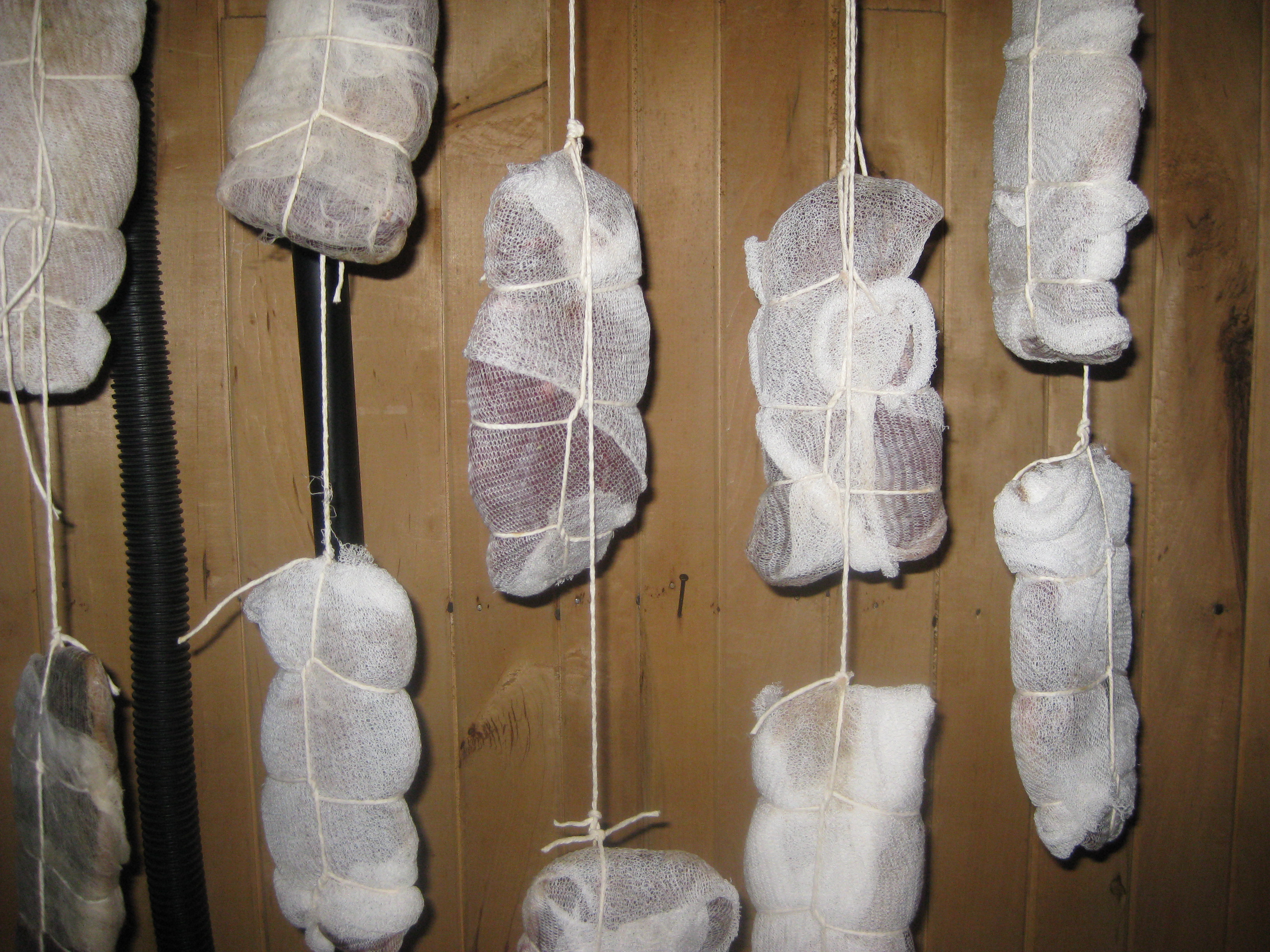 duck proscuito
duck proscuito
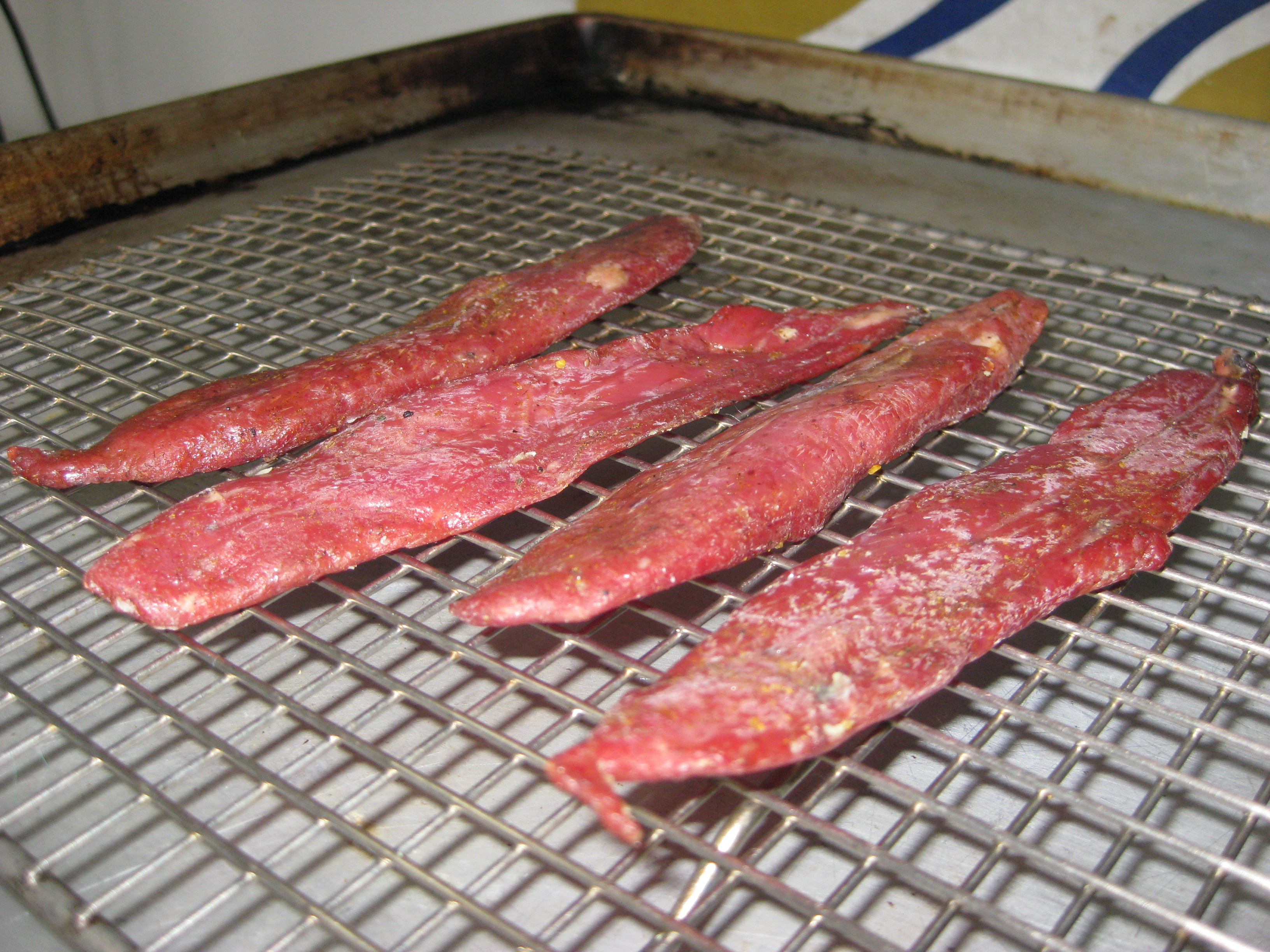 duck jerky
duck jerky
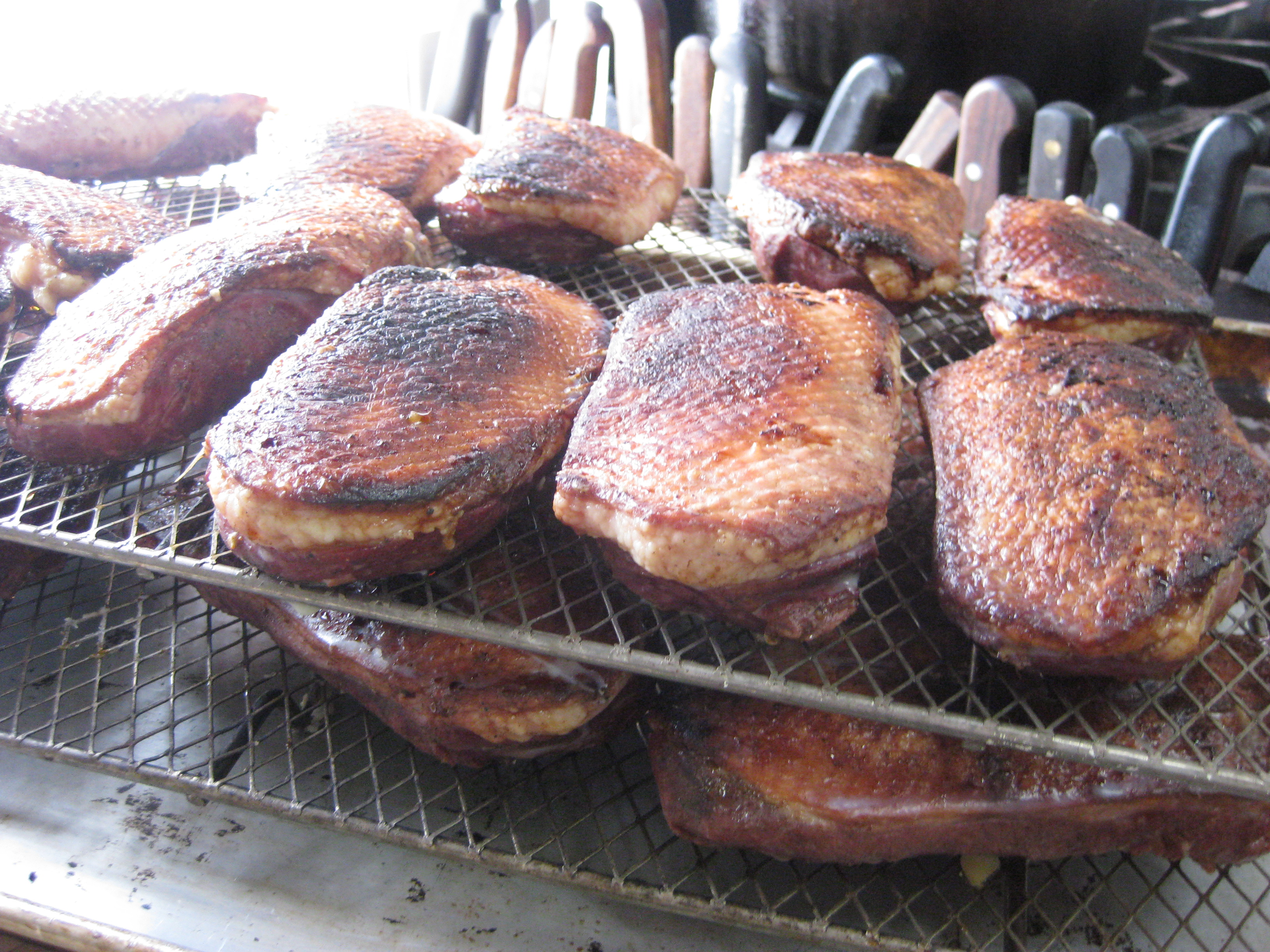 smoked duck my way, cooked not raw
smoked duck my way, cooked not raw
Soup wise, I can’t help but feel the need to go with a consommé, which is pure essence of duck. Duck broth is my base of choice (instead of chicken) year round and makes a great creamy soup or vegetable purée type as well, but I just love consommé; the extra steps are worth it. I clarify the duck stock with more duck (ground) and duck egg whites(keeping the yolks for the garnish or dessert, adding aromates of choice to the clarification raft. This time around it will be surprise, surprise – wild mushrooms!
 duck consommé with duck egg and sea spinach, sumac
duck consommé with duck egg and sea spinach, sumac
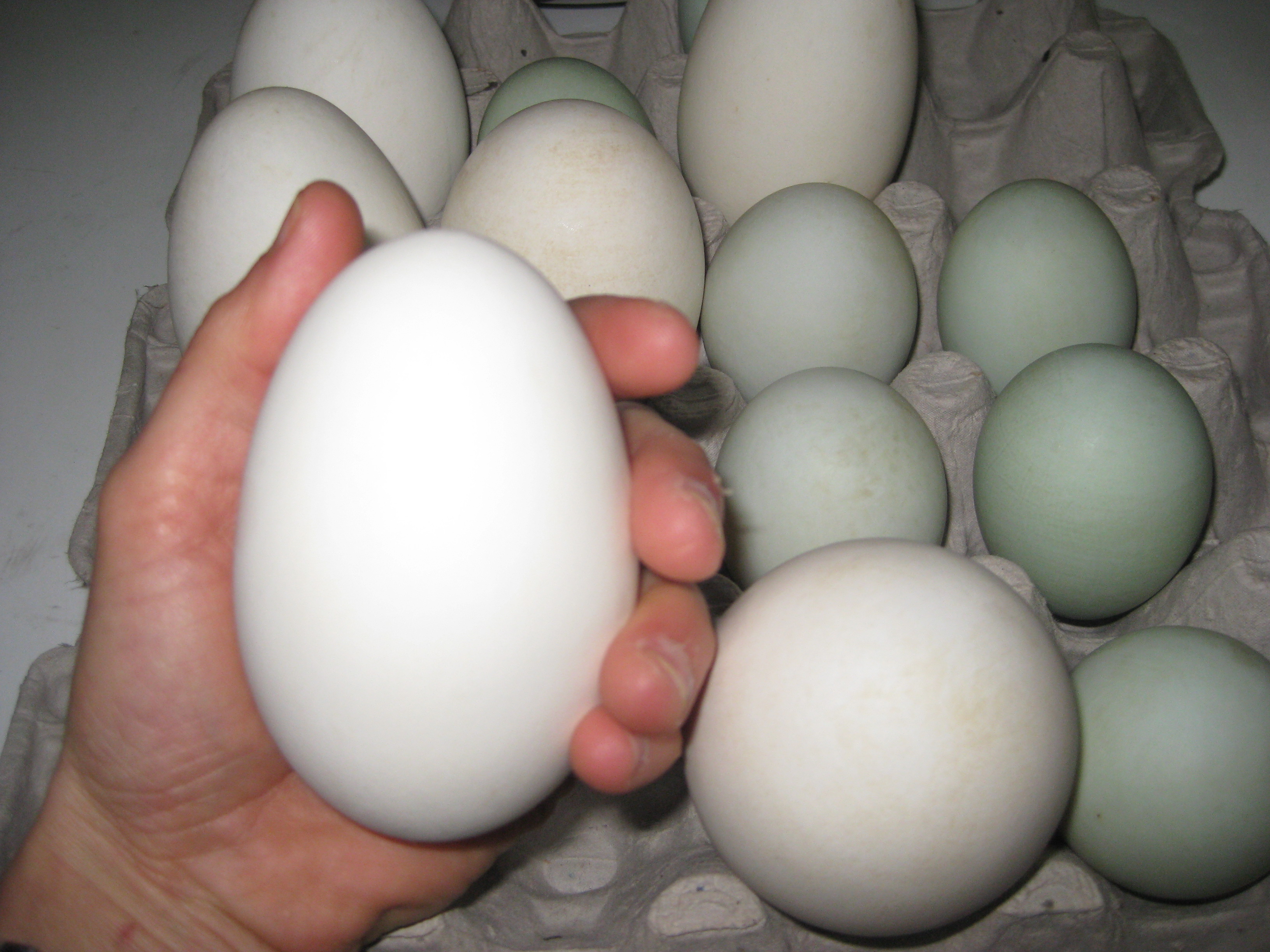 duck eggs
duck eggs
I used to put a whole duck egg on the menu as a second or third entrée - shirred, baked or poached - so delicious and appreciated by most customers but it is a bit much at 80-100g, like 2 chicken eggs.. In the last few years, I have favoured using egg as a component, going with a frittata, tortilla, egg crepe or an egg garnish.. This way the poor customer has a better chance of making it to the end. This year’s egg ‘noodle’ originated from a kind of accident turned experiment. One day, I had an excess of egg yolks so froze them and saw that they turned opaque, almost half cooked. Intrigued by this egg paste, I incorporated some fat and flavour (easily emulsified) and cooked up the cake sousvide/in a bain marie and loved the silky terrine results. A myriad of possibilities opened up: carpaccio, sheets, terrine, skin, slivers, and noodles!
Obviously, there has to be a ducky salad of some kind on any night, as close to a signature I get in my relentless motion. A classic at the restaurant anytime of year is the duck heart and gizzard salad, but it was time to give it a rest. François loves Caesar. If the rest of the menu isn’t too heavy, I can swing it, replacing bacon with my house smoked duck, using some of the duck yolks from before in the dressing, kick it up with crinkleroot and cook the croutons in duck fat.. switch up the capers for pickled daisy buds.
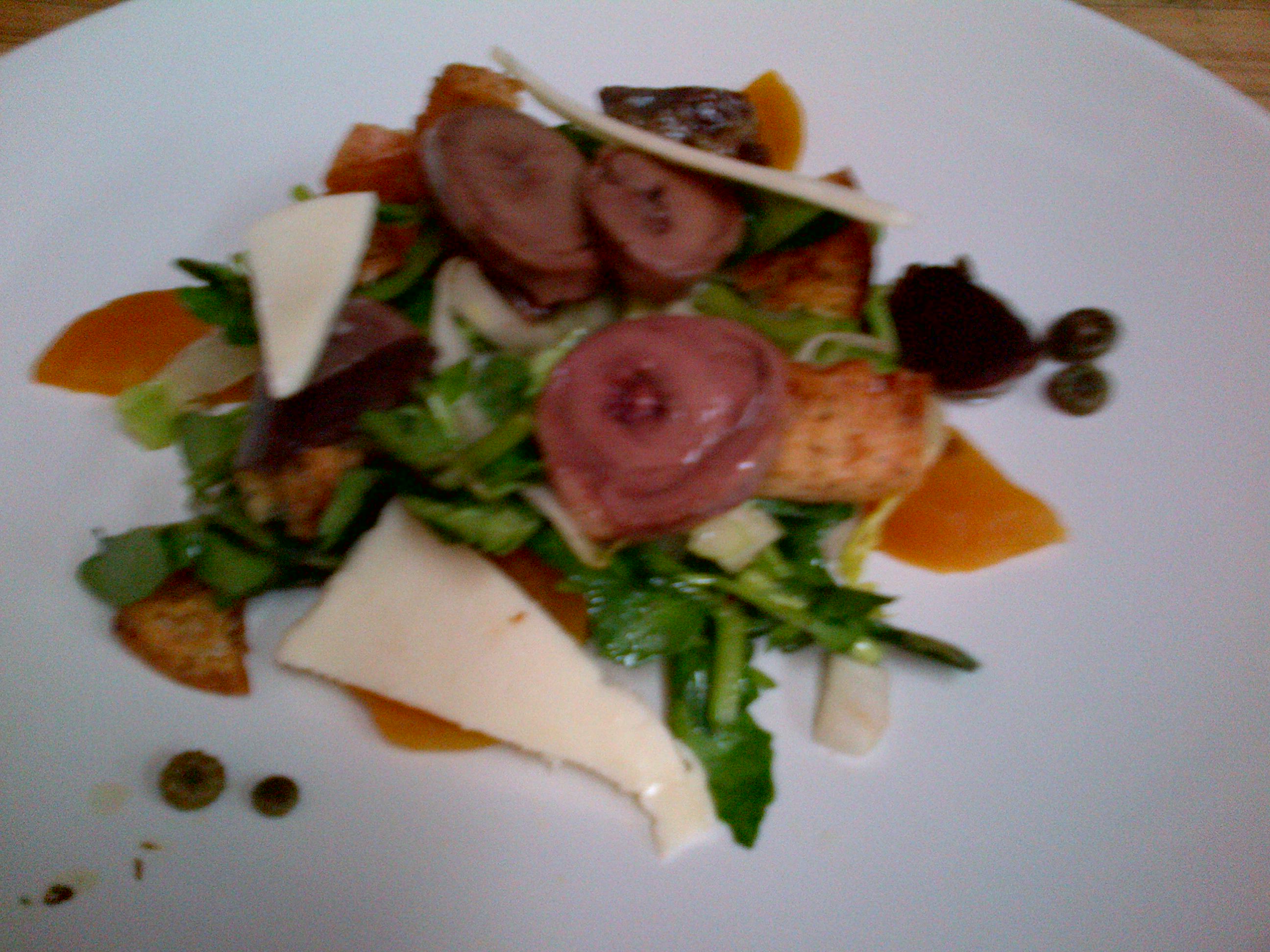
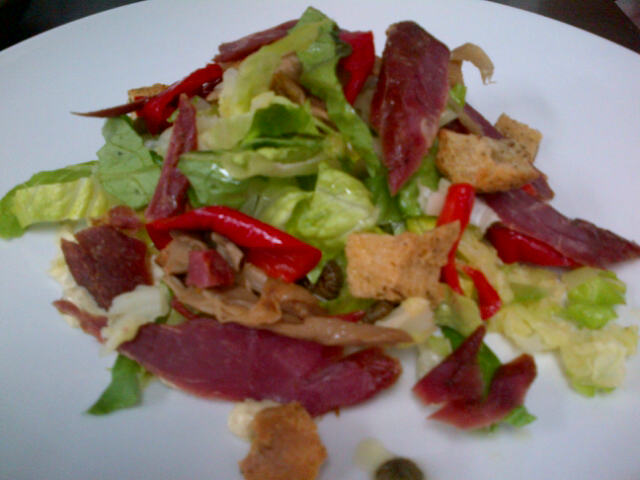
I’m done with cassoulet for a while, but now choucroute is my coup de Coeur of ducky winter dishes, including the incontournable confit and homemade duck sausage. Besides, I love cabbage and I’m into fermentation ever since my killer green beans from two summers ago.. As with proscuito, fermenting things is more conveniently a winter project when the room temp is easier to control and I have time to be patient and play around.. I haven’t had much success yet with cabbage, but I’ll get there..
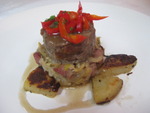 mini choucroute: confit, saucisse maison de canard, choux & genièvre
mini choucroute: confit, saucisse maison de canard, choux & genièvre
I felt like doing a fried chicken type of entrée for a change, or maybe something like ‘General Tao’ -any thing fried being a crowd pleaser. I’m constantly looking for novel ways beyond jerky to put the filets that I remove from the breast.to good use. And since duck is such a natural with ‘asian’ flavourings like soy, ginger, anise etc, there needs to be at least one course that goes in that direction. The duck fingers with wild ginger sauce below (or nuggets as Melinda coined them) was the result – and a staff favourite so far..
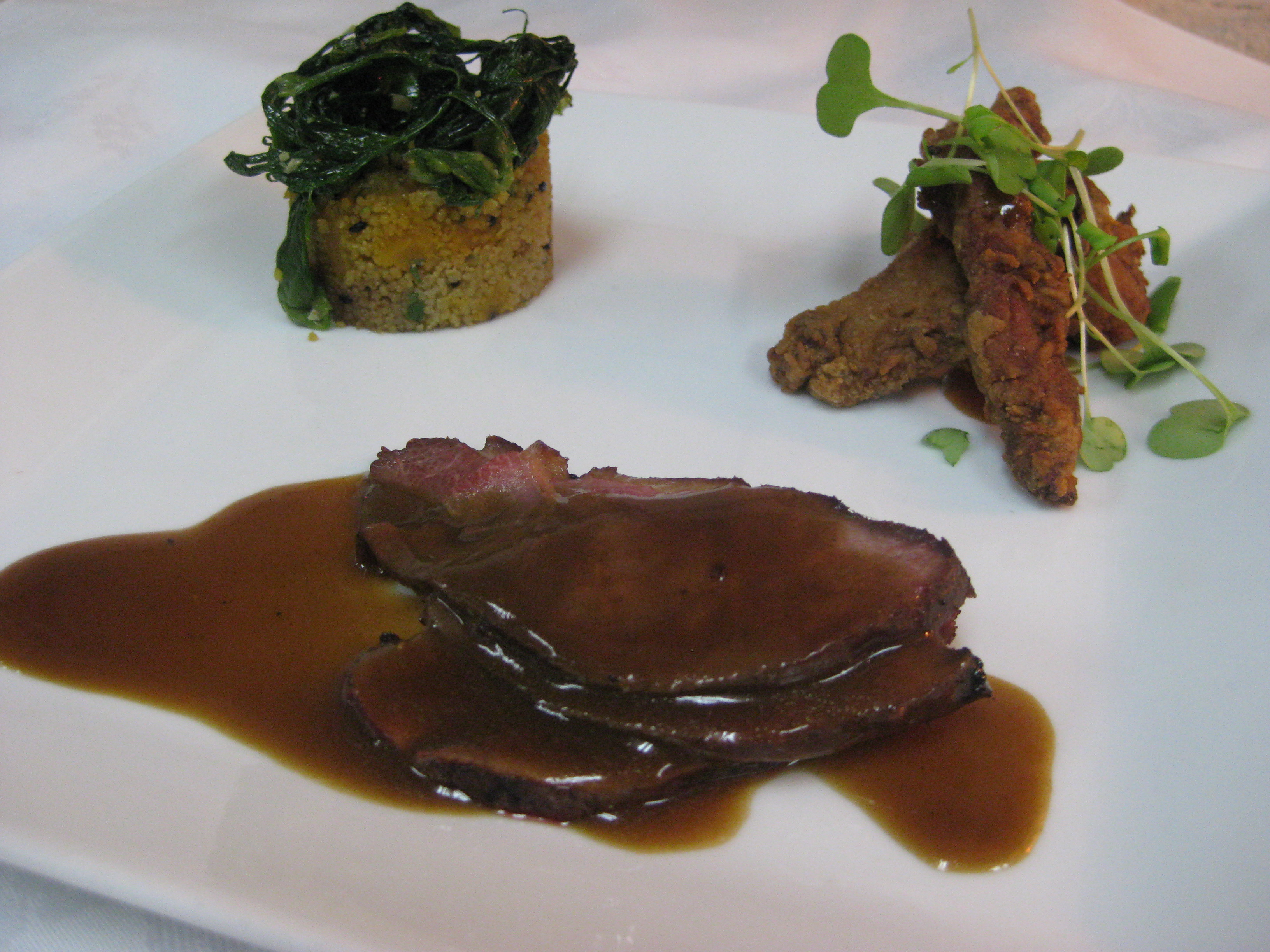 Muscovy duck supreme and fried duck fingers with wild ginger sauce, salsfis sprouts and sesame couscous
Muscovy duck supreme and fried duck fingers with wild ginger sauce, salsfis sprouts and sesame couscous
Besides a Ferme Morgan’s supreme pan-roasted with a fruity-spicy sauce of some sort, definite musts on the menu, too decadent and delicious to pass on, are duck fat potatoes and the cracklings made from the skin. I once served these as an amuse with the aperitif, bad idea! Everyone ate way too many of them. That’s another preferred snack among the waitresses that I have to keep an eye on, ‘Ca goutte le ciel, as Julie says.
To wind down the feast, there are inevitably duck egg desserts; one using the luxurious yolks, the other riffing on the springy whites. Watch out, these protein-rich whites make a surprisingly airy meringue!


As you can see, the possibilities with duck are endless. And with this cold weather, duck is just what the doctor ordered.
Here are some easy recipes (below) in case you are inspired to cook up some of this local-heart healthy meat over the winter.
Now that many duck products are quite widely available – duck stock, duck fat, confit duck, smoked duck etc.., there is no need for you to get into tricky stuff like charcuterie, making consommé, rendering fat even how to confit duck legs or making stock to enjoy a gourmet meal. It’s ok if you leave that time-consuming, messy stuff to us - the producers, chefs and butchers, the duck store (Le Canard Libéré on St-Laurent)..
Of course, you can always go all out and treat yourself to the ultimate ‘duck’ experience at Les Jardins Sauvages! Until February 3rd..
Duck recipes
Duck confit salad with ‘chimichurri’
6 p
Ingredients
3L wild/mixed greens (or romaine, watercress, endive)
400g cooked confit duck gizzards and hearts (or confit duck leg meat)
100g smoked duck magret, julienne
300g (1) potato (cubes)
250ml duck fat
120ml vinaigrette ‘chimichurri’ sauvage (spicy garlic and wild herb vinaigrette)*
100ml pickled mushrooms
2 scallions, chopped
au goût mushroom salt (or sea salt) & pepper
Method :
Heat duck fat in sturdy pot and add potato; cook gently on stovetop or in oven for 30min. Drain, season and finish in oven on baking sheet to crisp up.
Prepare greens (wash and dry, tear or chop).
Reheat the gizzards in some duck fat gently, or if in a vacuum pack, by submerging it in hot water 5min.
Toss the greens with scallions and half the vinaigrette, adding more vinaigrette and seasoning to taste.
Serve warm gizzards and potatoes on top. Garnish with smoked duck and pickled mushrooms.
*A garlicky red wine vinaigrette I make (and we sell) with wild garlic, chilli and a bunch of wild herbs (sea parsley, lovage, crinkleroot, garlic mustard leaf, bee balm..); could be replaced with any punchy vinaigrette that is sharp and slightly sweet with added herbs and garlic.
Duck Caesar salad with crinkleroot
6 p
Ingredients
3L wild/mixed greens (romaine, endive, watercress)
100g smoked duck magret, julienne
2c day old bread (cubes)
60ml duck fat
wild herb salt (or sea salt)
chopped herbs of choice
100g Capra or aged cheese of choice (that grates well)
2 scallions, chopped
20ml pickled daisy buds or capers
Crinkleroot Caesar dressing:
2tsp each minced garlic and crinkleroot
50ml minced anchovy (3-4)
3 egg yolks
1tsp crinkleroot mustard or Dijon
30ml white wine vinegar/lemon juice
30ml pickled daisy buds
60ml grapeseed oil
60ml EVO
salt, pepper
Tabasco, Worchestershire
Extra lemon to taste
Make croutons by tossing bread in rendered duck fat, season with salt and dried herbs, cook in oven at 350F for 15-20min or until golden and crunchy.
Make vinaigrette by mixing ingredients in a blender. Or combine yolks, garlic and mustard, half of lemon juice and slowly whisk in grapeseed oil. Add rest of lemon juice and continue with olive oil. Thin with a touch of oil or water to desired consistency. Season to taste.
Toss greens with half of vinaigrette, some of the cheese, s&p; adding more vinaigrette to taste. Plate salad and top with smoked duck, croutons and remaining cheese. Sprinkle extra daisy buds around.
Pan-seared duck supreme with elderberry/flower sauce
6 p
Ingredients
2 (1kg) duck supremes, skin side scored; filets kept for another use (Terrine, Jerky or Fried duck)
2 shallots, thinly sliced
thyme, peppercorn
20g butter
100ml honeywine or cider
500ml duck stock
250ml elderberries (or fruit/berry of choice, fresh or frozen)
10g (2Tbsp) elderflower (or peppercorn, juniper or rosemary)
s&p
cornstarch slurry
* In a sauce for duck, I like to combine something fruity and something spicy/herbal added later; instead of elderberry/flower combo, could be apple (1c chopped whole) and rosemary 2-3 sprigs, blackberry and juniper or raspberry and peppercorn...
Method:
Make sauce base: In a medium sauce pot, slowly caramelise shallots in a bit of butter/oil, add thyme and peppercorn and deglaze with wine, reduce down. Add duck stock and elderberries (or berry of choice). Simmer for at least 20min, allowing to reduce slowly. Add elderflower (or rosemary/juniper/herbs of choice) and let sit 5min. Strain.
Trim excess fat of duck supremes if necessary. With Muscovy, it isn’t necessary, but with Moulard or Pekin sometimes; you don’t want more than ½-1 cm/1/4”. So that there is some crispy but not too much flabby fat at end. Scoring with a knife helps the fat render/even cooking.
Heat sauté pan to med-high heat. Season duck supremes and add to pan skin side down (with no added fat). Once you start to see color, turn down to med or lower and cook for 8-10min. You want a slow caramelisation while rendering as much excess fat as possible. Pour off rendered fat a few times during the cooking. Flip and cook for 2-3min. Ideal is medium-rare. Rest in a warm place for 10min before slicing.
Degrease pan and pour in sauce base. Bring to a simmer season to taste, thicken to desired consistency with cornstarch slurry if desired (maybe 1Tbsp), swirl in butter.
Slice duck breast as thinly as possible against the grain of the meat, serve with sauce. Suggested accompaniments: Root vegetables, mushrooms, wild rice..
Duck jerky
6 p
Ingredients
8 (450g) duck filets (tenderloin) or one duck breast fat removed, sliced in 6x1.5cm thick strips
20g (1 Tbsp) brown sugar
5g (scant tsp) coarse salt
1g ea (generous pinch) pepper, smoked paprika, steak spice
.5g ea (small pinch) cumin, thyme, oregano
big squirt ea soy sauce/tamari
small squirt worchestershire
Method:
Toss with seasonings. Refrigerate overnight. Pat dry and put in a 200F on a rack in oven for 2hrs or until desired texture (dry and chewy, still sliceable).
Eat as a snack as is or slice up to garnish a salad, sandwich or canapé. Keep in fridge.
Baked duck egg with mushroom, smoked duck and tomato
6 p
Ingredients
6 duck eggs
30ml olive oil
200g wild mushrooms (or cultivated), chopped
2 french shallots, minced
15ml butter
s&p
drops lemon juice or cider vinegar/sherry vinegar
100ml heavy cream
5ml mushroom oil (and/or a few drops of truffle oil)
s&p
60g smoked duck, julienne
200ml chopped tomato
50ml chopped chives and/or parsley
pinch sugar, s&p, hot sauce
Method:
Sauté mushrooms in olive oil over medium-high heat for a couple of minutes; add butter and shallots, turn down to med/low and stew for 10 minutes; season.
Mix cream with mushroom oil (and/or a few drops of truffle oil), season.
Into buttered individual ramekins (4oz), divide mushroom mixture to cover bottom. Crack an egg into each one. Top with a tablespoon or two of cream mixture to cover.
Cook in a 325F oven for 15-20min until just set but still giggly.
Meanwhile prepare tomato salsa garnish. Add a pinch of sugar, salt and pepper to chopped tomato with fresh herbs and a bit of olive oil or mushroom oil, hot sauce to taste.
Serve ramekins of egg topped with salsa and smoked duck julienne.
Fried duck fingers with wild ginger sauce
6 p
Ingredients
12 duck filets
1/2c pastry flour (or half flour and cornstarch)
50ml plain yogurt
Marinade:
50ml soy sauce
50ml maple syrup
30ml lime juice
30ml wild ginger mustard
5ml toasted sesame oil
1tsp ea curry, five spice
hot pepper sauce (Sambal or Siracha)
Sauce:
2 shallots, thinly sliced
1tsp ea minced garlic, wild ginger
2c duck stock
2 sprigs thyme
1Tbsp± cornstarch slurry
30ml butter
Method:
Cut duck filets into 1” thick slivers (in 3).
Mix together marinade ingredients. Use half to season the duck filets, tossing to coat evenly with the yogurt.
Set aside for at least 20 min (or in the fridge hours or overnight).
Make sauce: slowly caramelise shallots in some butter. Add garlic and ginger, sauté a few minutes and add the rest of marinade. Deglaze with stock, reduce down by 1/3. Add thyme and coriander. Keep reducing another 5min to approximately half, tasting along the way. Rectify seasoning, use a little cornstarch slurry to thicken to desired consistency. To finish sauce, strain and swirl in butter off heat. Keep warm.
Pull duck from marinade, pat dry and coat with pastry flour. Fry duck by either deep frying at 350F for 2-3min or by pan-frying in a skillet with a good slick of hot vegetable or peanut oil for 3-4min (1-2 min each side). Remove onto paper towels, and serve with sauce. You can always coat the fried duck in sauce General Tao style but I prefer it separate.
Suggested accompaniments: rice, sautéed mushrooms and mustard greens, or rice noodles, lettuce, red pepper, bean sprouts, coriander and mint.. Could be finger food too!
